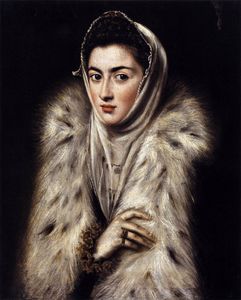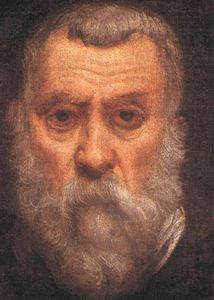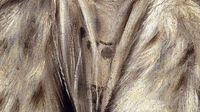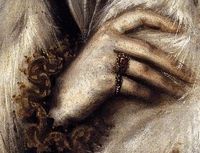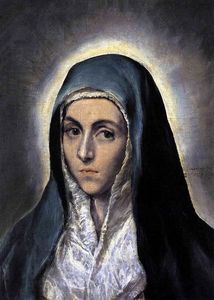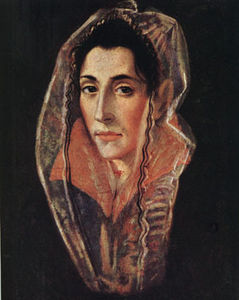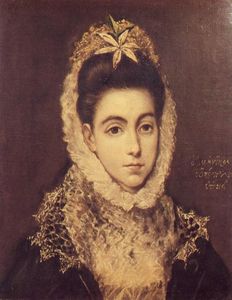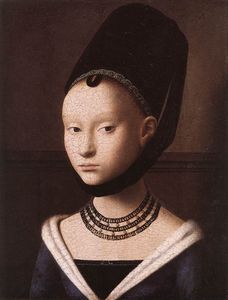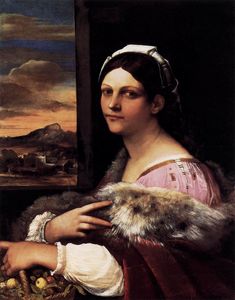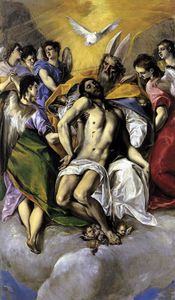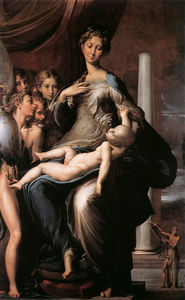Lady in a Fur Wrap
- Date of Creation:
- circa 1580
- Alternative Names:
- Lady with a Fur Stole
- Subject:
- Figure
- Art Movement:
- Mannerism
- Created by:
- Current Location:
- Glasgow, United Kingdom
- Displayed at:
- Kelvingrove Art Gallery and Museum
- Owner:
- Kelvingrove Art Gallery and Museum
- Lady in a Fur Wrap Page's Content
- Story / Theme
- Analysis
- Related Paintings
- Artist
- Art Period
- Bibliography
Lady in a Fur Wrap Story / Theme
While most people believe that the Lady in a Fur Wrap is a portrait of El Greco's beloved partner Jeronima, others are less convinced. Although he never married her, El Greco was in a loving relationship with Jeronima and she bore his only child around the same time this painting was completed.
Yet some critics are skeptical about El Greco's authorship since this work is so strikingly different from most of his others. People in this camp have proposed Tintoretto or Anguissola as possible creators for this piece.
However, similarities have been drawn between this painting and El Greco's The Virgin Mary (see Related Paintings below), with many arguing that both were painted using the same sitter.
Lady in a Fur Wrap Analysis
This work is so different from El Greco's other works, which mostly feature the harshly-lit, blue-hued tortured bodies of saints, martyrs and other religious figures. The Lady is the odd woman out among El Greco's blanched saints and venerable virgins: pulsing in pinks and reds, she beams with vitality.
Color palette:
The Lady in this portrait radiates with warm fleshy tones not often featured in El Greco's cool-toned work. While his color palate is primarily achromatic, El Greco chose to blush his subject's cheeks a vibrant pink and showcase her rosy red lips. This juxtaposition in colors brings out the woman's sensuality and mystery.
If you follow the theory that this is a portrait of El Greco's beloved, then his choice of a fleshy color palate perhaps reveals his affection and fondness for his sitter.
Brushstroke:
Adding to the woman's warmth and vitality is the tranquil smoothness with which El Greco painted her face. The smooth and calming brushstrokes of this finely featured face work in harmony with the color palette portray a tranquil, though alluring, and feminine figure.
This fine brush work is contrasted by the brisk strokes of her lynx fur wrap, sweeping graciously into the depthless black background.
The Hand:
Some art historians cite the Lady's smooth sleek hand as evidence of El Greco's better known Mannerist style. The fingers of El Greco's figures are characteristically long, thin, and expressive.
Spanish ladies of El Greco's time so coveted refined sleek hands that they would actually tie their wrists to the headboard at night to make their hands pale and bloodless by morning.
Lady in a Fur Wrap Related Paintings
Lady in a Fur Wrap Artist
El Greco, a Spanish painter with Greek heritage and Italian art training, completed this anomalous work in his mid-thirties after settling down in his adopted home of Toledo, Spain. While he completed a scant few portraits, most of his work was in the religious genre.
Due to its theme and break from El Greco's typical work, most experts believe he might have painted Lady in a Fur Wrap for personal, rather than professional reasons.
It was after relocating to Toledo, Spain that El Greco truly blossomed and received several major commissions. Although he rarely ventured away from religious paintings, when he did he created compelling portraits, landscape paintings, mythological works and sculptures, and those produced during his later years are particularly notable for their undulating forms, epic scale and expressive distortions.
El Greco regarded color as the most important element of painting, and declared that color had primacy over form. In his mature works he tended to dramatize rather than describe and the strong spiritual emotion of his works directly affects the audience.
Lady in a Fur Wrap Art Period
El Greco completed this painting during the Mannerist period, which, following on the heels of the High Renaissance, spanned the time from 1520 to about 1590.
While the life-like quality and muted tones of the Lady in a Fur Wrap are atypical of Mannerism, those elongated fingers, so characteristic of El Greco, are distinctly Mannerist.
Women of this time were so enamored with refined hands, some even tied their hands to the top of the bedpost at night so that, by morning, they would have achieved the pale and lifeless quality they so coveted.
El Greco's works were worlds apart from his contemporaries due to their dramatic and expressionistic style and it was not until the 18th century that his unique approach was appreciated.
The artist is seen as a forerunner of both Expressionism and Cubism and he also inspired writers and poets including Rainer Maria Rilke and Nikos Kazantzakis.
Marrying Byzantine traditions with Western painting, El Greco is renowned his elongated figures and often fantastic pigmentation and because of this many modern scholars believe that El Greco is a truly unique artists who broke the rules of all conventional schools.
Many regard El Greco as one of the finest painters of Spain, if not all of Western Art.
Lady in a Fur Wrap Bibliography
To read more about El Greco please choose from the following recommended sources.
• Alcolea, Santiago. El Greco. Ediciones Poligrafa, 2007
• Bray, Xavier. El Greco (National Gallery of London). Yale University Press, 2004
• Carr, Dawson W. El Greco to Goya: Spanish Painting (National Gallery Company). Yale University Press, 2009
• Davies, David. El Greco (National Gallery Company). Yale University Press, 2005
• Kazantzakis, Nikos. Report to Greco. Faber and Faber, 2001
• Scholz-Hansel, Michael. El Greco: Domenikos Theotokopoulos 1541 - 1614 (Taschen Basic Art Series). Taschen GmbH, 2004

